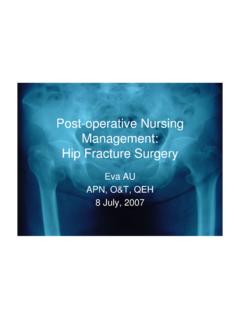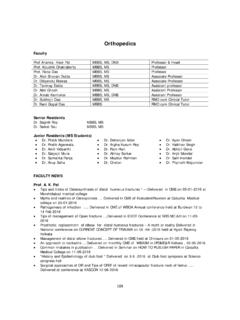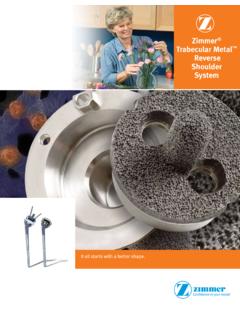Transcription of 249 Femoral Nerve Block- Landmark approach 2
1 Sign up to receive ATOTW weekly - email ATOTW 249 Femoral Nerve block , Landmark approach 06/02/2012 Page 1 of 12 Femoral Nerve block : Landmark approach ANAESTHESIA TUTORIAL OF THE WEEK 249 6TH FEBRUARY 2012 Dr Andrew McEwen, Specialist Registrar Anaesthesia Torbay Hospital, Torquay Correspondence to QUESTIONS Before continuing, try to answer the following questions. The answers can be found at the end of the article, together with an explanation. 1. Please answer True or False: The Femoral Nerve : a. Is derived from the dorsal rami of L2 to L4 b. Is covered by 2 fascial layers, the fascia lata and fascia iliaca c. Is contained within the Femoral sheath d. Emerges from the psoas muscle at its medial border. e. Divides into anterior (superficial) and posterior (deep) branches after passing under the inguinal ligament 2. Please answer True or False: The Femoral Nerve block provides: a.
2 Sensory block of the skin over the anterior aspect of the lower leg b. Motor block of the extensor muscles of the knee c. Sensory block of the skin over the lateral aspect of the hip joint d. Surgical anaesthesia for skin grafting from the anterior aspect of the thigh e. Analgesia for all lower leg surgery in combination with sciatic Nerve block 3. Please answer True or False: With regard to the performance of the Femoral Nerve block : a. Stimulation of the sartorius muscle implies the needle tip is too lateral b. The Femoral Nerve is usually found at the midpoint between the anterior superior iliac spine and pubic symphysis c. Directing the needle cranially and injecting a volume of 30mls will also result in blockade of the lateral Femoral cutaneous and obturator nerves d. Two distinct pops may be felt as the needle is advanced e. The correct motor endpoint is contraction of the patella INTRODUCTION The Femoral Nerve block is one of the easiest peripheral Nerve blocks to master because the landmarks are generally easy to identify and the Nerve is usually found at a superficial depth.
3 Historically, the technique was sometimes termed the 3 in 1 block because it was thought a single injection could block the Femoral , lateral Femoral cutaneous and obturator nerves. However, although the Femoral Nerve is reliably blocked, the lateral Femoral cutaneous Nerve is often missed and the obturator Nerve is almost always missed1,2. Sign up to receive ATOTW weekly - email ATOTW 249 Femoral Nerve block , Landmark approach 06/02/2012 Page 2 of 12 The block is usually performed as a single shot, however its duration of action may be extended with a catheter technique. When using a catheter local anaesthetic may be delivered by repeated boluses, patient controlled boluses or continuous infusion. The Femoral Nerve can be located using ultrasound guidance. This article will only discuss the single shot Femoral Nerve block performed using a Landmark approach .
4 The article will cover relevant anatomy, potential uses and block technique along with a brief trouble shooting section. ANATOMY The Femoral Nerve The Femoral Nerve is the largest branch of the lumbar plexus (Figure 1) and arises from the ventral rami of the second, third and fourth lumbar nerves. It descends through the substance of the psoas major muscle deep to the fascia iliaca emerging from the muscle at its lateral border. It continues caudally into the thigh via the groove formed between the psoas and iliacus muscles and passes under the inguinal ligament to enter the Femoral triangle. Here it lies on top of the iliacus muscle lateral to the Femoral artery. The Femoral Nerve lies outside of the Femoral sheath and is covered by two fascial layers, the fascia lata and fascia iliaca. The Femoral vessels, however, are only covered by a single layer, the fascia lata.
5 Thus the Nerve actually lies in a different tissue plane to the vessels. Immediately after passing under the inguinal ligament, the Femoral Nerve divides into anterior (superficial) and posterior (deep) branches. Clinically this is important because one of the branches can easily be missed if the block is not performed close to the inguinal ligament. The anterior branch provides motor innervation to the sartorius and pectineus muscles and sensory innervation to the articular surface of the acetabulum and skin of the anterior and medial thigh. The posterior branch provides motor innervation to the quadriceps muscle and sensory innervation via the saphenous Nerve . The latter provides the only sensory innvervation below the knee to have originated from the Femoral Nerve . It supplies the skin over the medial aspect of the leg down to the medial malleolus and descends through the thigh in the adductor canal with the Nerve to the vastus medialis muscle.
6 Figure 1. Right Lumbar Plexus. Note the Femoral Nerve arising from the 2nd, 3rd and 4th lumbar roots. Sign up to receive ATOTW weekly - email ATOTW 249 Femoral Nerve block , Landmark approach 06/02/2012 Page 3 of 12 Figure 2. Structures passing under the inguinal ligament. Note the Femoral Nerve is lateral to the Femoral vessels and lies outside the Femoral sheath. Anatomical variations The Femoral Nerve may arise from the ventral rami of T12 to L4 (prefixed) or from L1 to L5 (postfixed). Rarely the Nerve may be found within the iliopsoas muscle or between the Femoral vessels. Applied Anatomy Dermatomal innervations The Femoral Nerve innervates the skin over the antero-medial aspect of the thigh and knee, and the medial border of the leg and medial malleolus (via the saphenous Nerve ). Myotomal innervations The Femoral Nerve innervates the following muscles: sartorius, quadriceps femoris (rectus femoris, vastus lateralis, vastus intermedius and vastus medialis), iliopsoas and pectineus.
7 Osteotomal innervations The Femoral Nerve innervates the anterior wall of the hip joint, the anterior aspect of the femur and the anteromedial walls of the knee joint. INDICATIONS As with all blocks a FNB can reduce systemic opiate requirements with their side effects. This may be particularly important in the elderly or those with respiratory disease. Thus the Femoral Nerve block can be performed to provide perioperative analgesia for fractured neck/shaft of femur or postoperative analgesia after knee surgery. It can also be used to provide surgical anaesthesia, usually in combination with a sciatic Nerve block . This may be advantageous in situations where it would be preferable to avoid general or neuraxial anaesthesia. Sign up to receive ATOTW weekly - email ATOTW 249 Femoral Nerve block , Landmark approach 06/02/2012 Page 4 of 12 Analgesia After knee surgery, for example total knee arthoplasty (with/without sciatic Nerve block ) or anterior cruciate ligament repair.
8 Please note that in most patients a Femoral Nerve block alone will not provide adequate analgesia of the knee due to significant contributions from the sciatic and obturator nerves. When combined with a sciatic or popliteal block , a Femoral Nerve block can provide analgesia for above and below knee amputations. For plaster applications in children with Femoral fracture. Perioperative analgesia in fractured neck/shaft of femur (can be useful to facilitate patient positioning prior to neuraxial block ). Adjuvant analgesia following hip surgery (for example after total hip replacement). Please note that a Femoral Nerve block alone will not provide complete analgesia of the hip due to contributions from the subcostal, iliohypogastric, lateral Femoral cutaneous, sciatic and obturator nerves. Therefore it is not commonly used in these cases.
9 Anaesthesia Femoral Nerve block alone: skin graft or muscle biopsy from the anterior aspect of the thigh. In combination with sciatic and obturator Nerve blocks: knee surgery In combination with a sciatic/popliteal block : any procedure on the lower leg or foot. CONTRAINDICATIONS Absolute Patient refusal. Inflammation or infection over injection site. Allergy to local anaesthetics. Relative Anticoagulation or bleeding disorders. The presence of a prosthetic Femoral artery graft. Where dense sensory block could mask compartment syndrome (for example fractures of the tibia or fibula). If unsure discuss with the surgeons prior to performing the block . Pre-existing peripheral neuropathies. GENERAL PREPARATION Before starting ensure there are appropriate indications for a Femoral Nerve block and no contraindications. Consent the patient and advise them on the likely duration of block .
10 Emphasise that assistance will be required to mobilise (due to quadriceps muscle weakness) until the block has completely worn off. Ensure the site/side is clearly marked, the patient is monitored and cannulated and that appropriate, assistance, equipment and resuscitation drugs are available. For complete details on preparation for peripheral Nerve blocks please see ATOTW tutorial Peripheral Nerve blocks Getting started . Sign up to receive ATOTW weekly - email ATOTW 249 Femoral Nerve block , Landmark approach 06/02/2012 Page 5 of 12 Specific equipment required 22-gauge 5cm long, short-bevelled insulated stimulating regional block needle. Skin antiseptic solution. Sterile gloves, marking pen and surface electrode. Peripheral Nerve stimulator. 1-2 ml of 1% lignocaine for skin infiltration in awake patients. 20 ml of long-acting local anaesthetic, Bupivacaine, Levobupivacaine or Ropivacaine.













